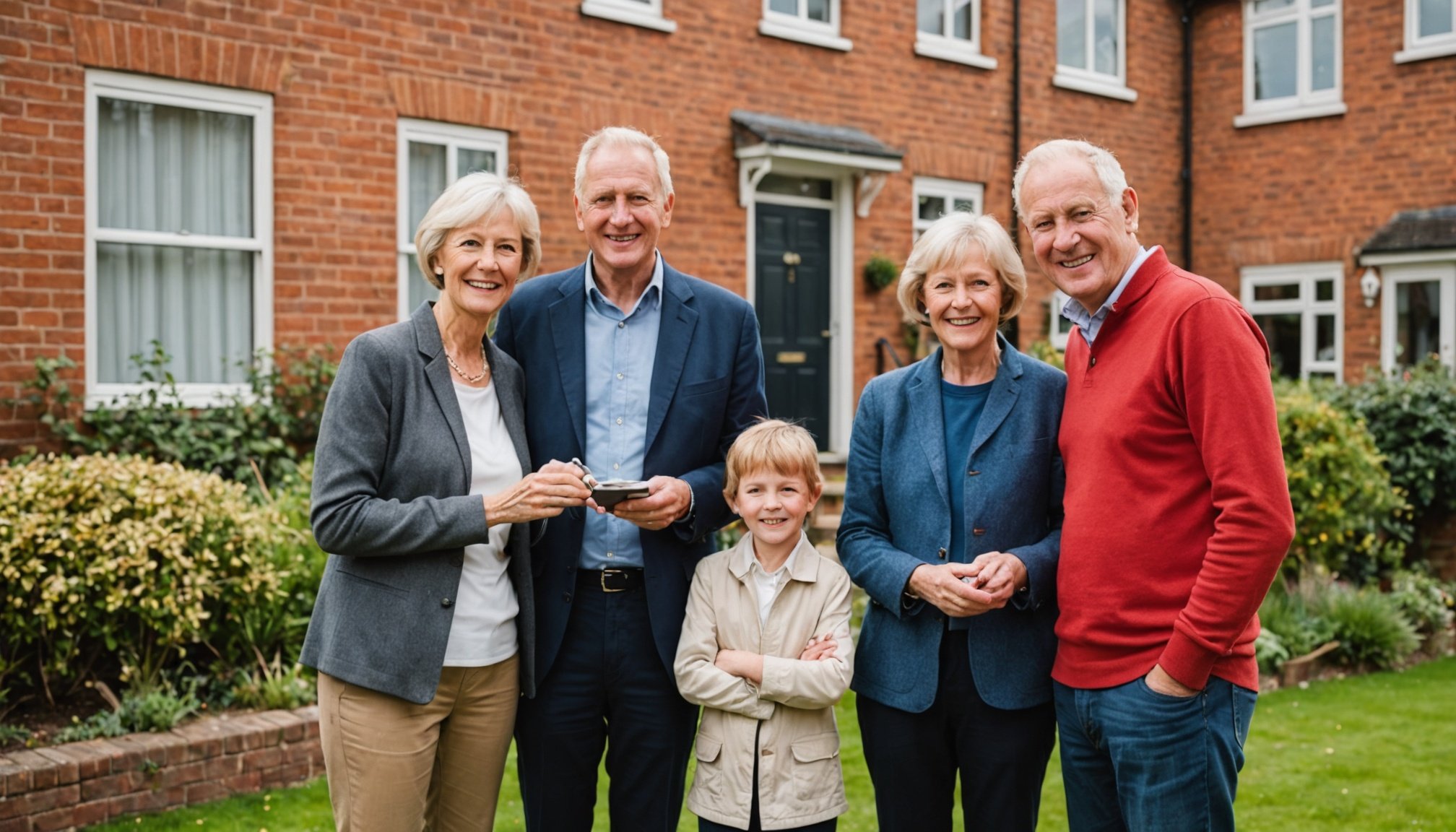Understanding Multi-Generational Living
Multi-generational living is gaining traction, particularly in the UK, as families choose to reside under one roof to support each other emotionally, financially, and practically. This lifestyle offers numerous benefits of shared living. It facilitates the pooling of resources, reducing costs for all residents. For landlords, this trend means access to diverse tenants, enhancing property attractiveness and profitability.
Landlords accommodating multi-generational setups may find themselves adjusting property layouts or amenities to suit varying needs. The demographic shifts highlight an increase in older adults living with their children and grandchildren, prompting many to seek flexible leasing options and innovative living arrangements.
Also to see : Transform your property listings with stunning real estate photography
For tenants, the benefits of shared living are profound. It includes improved tenant diversity, fostering richer community ties within households. Residents can enjoy mutual support in household management, childcare, and eldercare, adding immeasurable value to shared accommodation.
Moreover, these shifts reflect broader trends in property management. As the dynamics of family life evolve, there’s a greater need for understanding and adapting to accommodate diverse ages and living arrangements. This calls for property managers to be savvy and responsive, ensuring that they meet the unique challenges presented by today’s multi-generational homes. Understanding these dynamics is key to thriving in the real estate landscape.
In the same genre : Unlocking Compliance: A Developer”s Guide to Meeting Scotland”s Energy Efficiency Standards for New Constructions
Design Modifications for Multi-Generational Homes
Incorporating design modifications in multi-generational homes is pivotal for creating spaces that encourage both independence and togetherness. Such homes require property adaptation to cater to individuals of varying ages and needs.
Creating Separate Living Areas
To effectively implement multi-generational living, establishing distinct yet connected living areas is essential. This strategy enables each generation to enjoy privacy while still fostering familial bonds. Consider designing functional spaces like separate bedrooms or suites complete with bathrooms, enabling autonomy and personal space.
Enhancing Shared Spaces
In addition to individual areas, optimizing shared spaces is crucial. Design elements such as open-plan kitchens and living rooms promote communal interaction, making everyday activities more engaging for all family members. These adaptations ensure that the home environment feels inclusive, enhancing family relationships.
Accessibility Considerations
Balancing private and communal areas often necessitates accessibility features. Installing ramps, widening doorways, and using non-slip flooring are just a few modifications that accommodate mobility concerns and make homes user-friendly for all ages. This consideration ensures that every resident can navigate their home with comfort and ease, highlighting the importance of accessibility features.
Including these thoughtful design elements not only provides a harmonious living experience but also future-proofs the home for changing family dynamics.
Legal Considerations for Multi-Generational Rentals
In the UK, landlords must navigate a complex landscape of property laws and regulations when renting homes to multi-generational families. This includes ensuring all tenancy agreements are clear and accommodate such arrangements. For instance, agreements should explicitly recognise the rights and responsibilities of each occupant, thereby minimizing potential disputes.
Adapting tenancy agreements for multi-generational living involves detailing the use of shared spaces and specifying any restrictions to prevent misunderstandings. Additionally, it is important to outline how the responsibilities for utilities and maintenance are distributed. Tailoring these agreements can significantly enhance harmony among tenants and ensure a smooth rental experience.
Ensuring compliance with safety and health regulations is another critical legal consideration. Landlords must verify that properties meet all required safety standards, such as those for fire escapes, gas, and electrical systems. Regular inspections and certifications are necessary to remain compliant with the law. Moreover, adaptations for accessibility might be required to accommodate elderly tenants or those with disabilities.
In summary, thorough consideration of legal obligations and bespoke agreements are essential for successful multi-generational rentals. Understanding these legal aspects not only protects the landlord but also creates a fair and secure environment for all occupants.
Financial Implications of Transforming Properties
Delving into property transformations can be a rewarding venture, but it necessitates careful scrutiny of financial considerations. While upfront costs might be intimidating, aligning these with investment strategies can yield substantial long-term benefits.
Initial Investment vs. Long-term Gains
The initial expenditure for transforming a property includes design modifications and renovation logistics. Nevertheless, these investments often result in lucrative returns, enhancing property value significantly. By considering cost-effectiveness, investors can assess whether initial expenses can be recouped over time through increased property value or rental income.
Government Grants and Support
In many regions, government grants and financial support exist to encourage property improvements. These programs can mitigate initial capital costs, offering homeowners an opportunity to transform properties without shouldering full financial burdens. Exploring available grants can lead to surprisingly economical renovation strategies.
Understanding Rental Yield
Rental yield is a crucial metric for property investors. It evaluates the annual rental income against property value, reflecting the viability of a property as an investment. By understanding rental yield, property owners can make informed decisions about whether their transformed property can generate sufficient returns. Calculating rental yield involves analyzing costs, revenues, and market dynamics, enabling landlords to optimize their investment approach and maximize profitability.
Marketing to Multi-Generational Tenants
Marketing to multi-generational tenants requires a tailored approach to accommodate the diverse needs and preferences within these households. To create effective tenant marketing strategies, it is essential to focus on messages that resonate with various family members. One strategy is to emphasize the adaptability and spaciousness of multi-generational homes. Highlight features such as multiple living areas, versatile room layouts, and accessibility options that cater to both younger and older family members.
To reach target audiences, it’s crucial to utilize the right platforms and communication channels. Social media is a powerful tool, as it allows marketers to connect with a wide range of age groups simultaneously. Facebook and Instagram are particularly effective for reaching both parents and young adults, while platforms like LinkedIn might appeal to older generations.
Additionally, online property listings should vividly describe attributes appealing to families, such as proximity to schools, community centres, and parks. Including virtual tours in your marketing materials can provide prospective tenants with an engaging and informative preview of the property.
Finally, personalising your approach by directly addressing the needs and aspirations of multi-generational families will enhance your strategy. This could involve testimonials from current tenants or showcasing family-friendly amenities. Building a narrative around the property as a place where families grow together can significantly enhance its appeal.
Case Studies on Successful Transformations
Exploring case studies of successful property transformations offers valuable insights for landlords and homeowners aiming for effective design changes.
Case Study 1: A Family-Oriented Layout
Transforming a property for families often involves creating flexible spaces that adapt to varied needs. One notable success story in the UK focused on converting a traditional two-bedroom flat into a family-friendly haven. The redesign added an open-plan living area, fostering interaction among family members. Key elements included a multifunctional kitchen island and durable materials suitable for children. Following the transformation, tenant satisfaction surged due to improved space utilisation and child-friendly amenities.
Case Study 2: Accessibility-First Design
Creating accessible rental properties ensures inclusivity for a broader audience. A prime property transformation example involved a Victorian terrace retrofitted with wider doorways and a lift for wheelchair users. The enhancements prioritised accessibility without compromising style. Tenant feedback highlighted increased comfort and reduced barriers to home mobility. It underscored the importance of thoughtful design in meeting diverse needs.
Case Study 3: Efficient Use of Shared Spaces
Shared living arrangements benefit from efficient space use. An award-winning project redesigned a co-living space by optimising communal areas. The addition of modular furniture allowed dynamic adjustments to fit varying group activities. Feedback from tenants revealed heightened community engagement and satisfaction, demonstrating the role of adaptable designs in fostering a welcoming environment.
Optimizing Property Layouts for Shared Living
Creating optimized layouts for shared living environments involves careful consideration and space planning. The principles of effective space planning for multi-generational homes focus on balancing communal and private spaces. These homes must accommodate both shared areas for family interactions and private zones for solitude, a task that requires innovation and thoughtful design solutions.
One essential factor in maximizing common areas is employing open-plan designs. This approach fosters a sense of unity and fluidity, allowing family members to interact seamlessly. Moreover, carefully selected furnishings and fixtures can delineate zones without the need for rigid walls, thus enhancing flexibility and accessibility.
Privacy can be effectively achieved by segmenting the living areas and integrating soundproofing materials as needed. For instance, using sliding partitions or dividers can transform one large room into smaller, private spaces when necessary.
Incorporating innovative layout solutions such as loft spaces or modular furniture allows for adaptability and can cater to diverse family needs. This not only maximizes the utility of the entire property but also ensures comfort for all residents by addressing individual and collective desires.
Finally, focusing on shared living solutions can greatly improve the quality of life within these environments, ensuring that both communal and individual needs are met proficiently.











